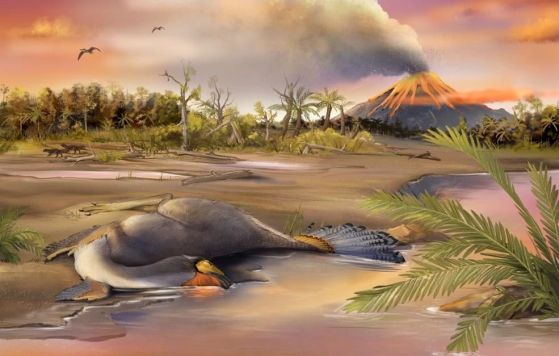Chinese scientists have isolated perfectly preserved dinosaur cartilage cells 125 million years old. The cells contain nuclei with residues of organic molecules and chromatin.
The study is published in Communications Biology.
The dinosaur, called Caudipteryx, was omnivorous, small in size as a peacock with long tail feathers. He toured the shores of the shallow lakes of Jehol Biota in Liaoning Province during the early Cretaceous.
“Geological data has accumulated over the years and shows that the preservation of fossils in the Biota Jehol is solely due to the fine volcanic ash that bury the corpses and preserve them to the cellular level,” said study co-author Li Zhiheng, an associate professor at the Institute of Paleontology and Paleoanthropology of Vertebrates (IVPP) of the Chinese Academy of Sciences.
Paleontologists remove a piece of distal articular cartilage from the right femur of this specimen, decalcify it, and use various microscopic and chemical methods to analyze it. They understand that all cells are mineralized by silicification (enrichment with silica, quartz) after the death of the animal. This silicification most likely allowed the excellent preservation of these cells.
The researchers also found two main types of cells: cells that were healthy at the time of fossilization, and less healthy cells that were porous and that began the process of fossilization while the dinosaur was dying.
“It is possible that these cells were dead before the animal died,” explains Alida Bailleul, an IVPP associate professor and co-author of the study.
Cell death is a process that occurs naturally throughout the life of all animals. But the ability to fit a fossilized cell at a specific location in the cell cycle is something completely new in paleontology. This is one of the goals of IVPP scientists: to improve cell images in fossils.
The team also isolated some cells and stained them with a chemical used in biological laboratories called hematoxylin. This purple chemical is known to bind to cell nuclei. After staining the dinosaur material, a dinosaur cell showed a purple nucleus with some darker purple threads. This means that a 125-million-year-old dinosaur cell has such a well-preserved nucleus that it retains some of the original biomolecules and chromatin strands.
Chromatin in the cells of all living organisms on Earth is made up of tightly packed DNA molecules. Thus, the results of this study provide preliminary data that suggest that remnants of the original dinosaur DNA may still be preserved. But to verify just that, the team still has a lot of work to do and uses chemical methods that are much more sophisticated than the staining used in the study.
“Let’s be honest, we’re obviously interested in fossilized cell nuclei, because that’s where most of the DNA should be if DNA is preserved,” says Alida Baileul. Last year, she published another study showing the exceptional preservation of nuclear and biomolecules in the cartilage cells of a Montana dinosaur. So, we have good preliminary data, very exciting data, but we are just beginning to understand cellular biochemistry in very old fossils. From now on, we need to work harder. “
The team insists that many more analyzes be done and even new methods be developed to understand the processes that may allow biomolecules to be preserved in dinosaur cells, because no one has ever successfully sequenced dinosaur DNA.
Sequencing is used to confirm whether ancient DNA is preserved in fossils. So far, this method has only worked for young fossils (not much older than about a million years), but they have never worked for dinosaur material. Dinosaurs are considered too old to preserve DNA. Chemical data collected by scientists from IVPP and STM show otherwise.
Although more data needs to be collected, this study definitely shows that 125-million-year-old fossil dinosaur cells cannot be considered 100% stone. They are not completely “petrified”. They may still contain residues of organic molecules. It is now vital to understand exactly what these molecules are, whether any biological information and DNA debris has been preserved.
Photo: Reconstruction of Biota Jehol and a well-preserved specimen of Caudipteryx. Credit: Zheng Qiuyang
Reference: Zheng, X. et al. Nuclear preservation in the cartilage of the Jehol dinosaur Caudipteryx. Communications Biology (2021). DOI: 10.1038 / s42003-021-02627-8
Source: Organic molecule remnants found in the nuclei of ancient dinosaur cells
Chinese Academy of Sciences












